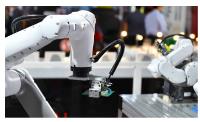 Add My Company
Add My Company
Sign In

Robot arms, also known as industrial robots, have been revolutionizing the manufacturing industry for decades. These machines are designed to carry out repetitive and dangerous tasks, allowing human workers to focus on more complex and skilled tasks. In this blog post, we will explore the advantages of using robot arms in production, as well as examine the industries that are currently utilizing this technology.
Advantages of using robot arms in production
Robot arms have many benefits when it comes to increasing efficiency and productivity in manufacturing. One of the main advantages is improved accuracy and precision. Robot arms can perform tasks with a high degree of accuracy and consistency, reducing the chance of human error.
Another significant advantage is the reduction of labour costs. Robot arms can work around the clock without the need for breaks or time off, allowing for a constant and efficient production process. This can save manufacturers a significant amount of money in the long run.
Flexibility and adaptability are another benefit of using robot arms in production. These machines can be programmed to carry out a wide range of tasks and can be quickly reprogrammed to adapt to changing production needs. This allows manufacturers to easily change their production line without the need to retrain human workers constantly.
Enhanced safety for workers is another advantage of using robot arms in production. These machines can handle dangerous and heavy tasks, reducing the risk of injury to human workers. This is particularly important in industries that involve hazardous materials or heavy machinery.
Examples of industries that are currently using robot arms in production
Robot arms are being used in a wide range of industries, including the automotive industry, pharmaceutical industry, food and beverage industry, and logistics and warehousing.
The automotive industry is one of the biggest users of robot arms in production. These machines are used to carry out tasks such as welding, painting, and assembly. They can work quickly and efficiently, reducing the need for human workers and increasing production speeds.
The pharmaceutical industry is also utilizing robot arms in production. These machines are used to handle and package drugs, as well as carry out tasks such as labelling and inspection. This helps to increase the speed and efficiency of the production process, while also reducing the chance of human error.
Food and beverage manufacturers are also using robot arms in production. These machines are used to carry out tasks such as packaging and palletizing, as well as inspecting and sorting food products. This helps to increase the speed and efficiency of the production process, while also reducing the chance of human error.
Logistics and warehousing are other industries that are utilizing robot arms in production. These machines are used to carry out tasks such as sorting and picking, as well as handling and loading goods. This helps to increase the speed and efficiency of the production process, while also reducing the need for human workers.
Future developments and advancements in robot arms technology
The field of robotics is constantly evolving and advancing, and we can expect to see many new developments in the use of robot arms in production. AI and
machine learning advancements will allow robot arms to become even more efficient and adaptable.
We can also expect to see increased collaboration between humans and robots in the future. This will involve the use of robots that are able to work alongside human workers, rather than replace them. This will help to increase the efficiency and productivity of the production process.
Another area of development is the creation of more advanced robotic arm attachments. This will include the development of new grippers and swivels, as well as other specialized attachments. This will allow robot arms to carry out even more complex tasks. Advancements in safety and security measures will also be an important area of development for robot arms in the future. As the use of robot arms becomes more widespread, it will be important to ensure that they are safe for human workers to be around. This will involve the development of new sensors and safety systems, as well as the use of advanced robotics software.
Conclusion
In conclusion, robot arms have many advantages when it comes to increasing efficiency and productivity in manufacturing. They can improve accuracy and precision, reduce labour costs, increase flexibility and adaptability, enhance safety for workers and handle heavy or dangerous tasks. A wide range of industries is currently using robot arms in production, from automotive to pharmaceutical and food and beverage to logistics and warehousing. With advancements in AI, machine learning, a collaboration between humans and robots and the development of more advanced robotic arm attachments, the future of robot arms in production looks promising.
Note:
It’s important to note that while robots can reduce labour costs, they also require maintenance, repair, and replacement, which may add costs to the business. Moreover, the implementation of robot arms in production may require additional investments, such as in training and retraining the workforce, but this will vary depending on the company and industry. It’s important for companies to evaluate the costs and benefits of implementing robot arms in their production processes before deciding.
For more information on Revolutionizing Manufacturing: The Advantages of Using Robot Arms in Production talk to Robot System Products
Enquire Now
List your company on FindTheNeedle.
